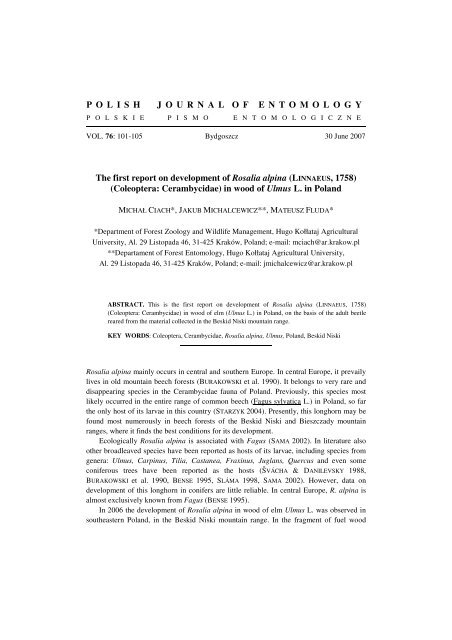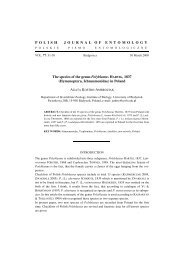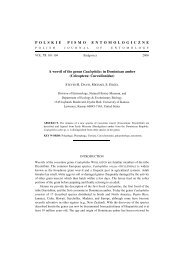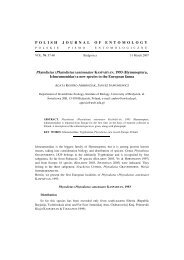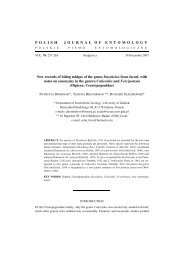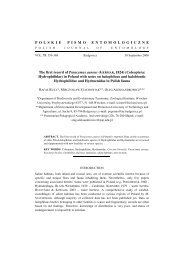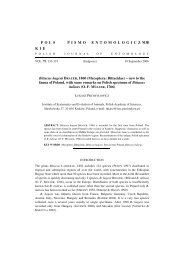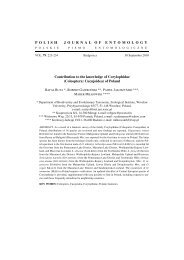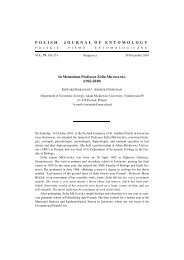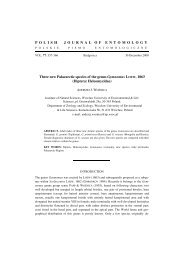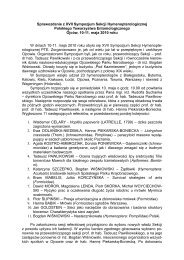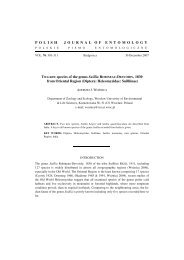P O L I S H J O U R N A L O F E N T O M O L O G Y The first report ...
P O L I S H J O U R N A L O F E N T O M O L O G Y The first report ...
P O L I S H J O U R N A L O F E N T O M O L O G Y The first report ...
You also want an ePaper? Increase the reach of your titles
YUMPU automatically turns print PDFs into web optimized ePapers that Google loves.
P O L I S H J O U R N A L O F E N T O M O L O G Y<br />
P O L S K I E<br />
P I S M O<br />
E N T O M O L O G I C Z N E<br />
VOL. 76: 101-105 Bydgoszcz 30 June 2007<br />
<strong>The</strong> <strong>first</strong> <strong>report</strong> on development of Rosalia alpina (LINNAEUS, 1758)<br />
(Coleoptera: Cerambycidae) in wood of Ulmus L. in Poland<br />
MICHAŁ CIACH*, JAKUB MICHALCEWICZ**, MATEUSZ FLUDA*<br />
*Department of Forest Zoology and Wildlife Management, Hugo Kołłataj Agricultural<br />
University, Al. 29 Listopada 46, 31-425 Kraków, Poland; e-mail: mciach@ar.krakow.pl<br />
**Departament of Forest Entomology, Hugo Kołłataj Agricultural University,<br />
Al. 29 Listopada 46, 31-425 Kraków, Poland; e-mail: jmichalcewicz@ar.krakow.pl<br />
ABSTRACT. This is the <strong>first</strong> <strong>report</strong> on development of Rosalia alpina (LINNAEUS, 1758)<br />
(Coleoptera: Cerambycidae) in wood of elm (Ulmus L.) in Poland, on the basis of the adult beetle<br />
reared from the material collected in the Beskid Niski mountain range.<br />
KEY WORDS: Coleoptera, Cerambycidae, Rosalia alpina, Ulmus, Poland, Beskid Niski<br />
Rosalia alpina mainly occurs in central and southern Europe. In central Europe, it prevaily<br />
lives in old mountain beech forests (BURAKOWSKI et al. 1990). It belongs to very rare and<br />
disappearing species in the Cerambycidae fauna of Poland. Previously, this species most<br />
likely occurred in the entire range of common beech (Fagus sylvatica L.) in Poland, so far<br />
the only host of its larvae in this country (STARZYK 2004). Presently, this longhorn may be<br />
found most numerously in beech forests of the Beskid Niski and Bieszczady mountain<br />
ranges, where it finds the best conditions for its development.<br />
Ecologically Rosalia alpina is associated with Fagus (SAMA 2002). In literature also<br />
other broadleaved species have been <strong>report</strong>ed as hosts of its larvae, including species from<br />
genera: Ulmus, Carpinus, Tilia, Castanea, Fraxinus, Juglans, Quercus and even some<br />
coniferous trees have been <strong>report</strong>ed as the hosts (ŠVÁCHA & DANILEVSKY 1988,<br />
BURAKOWSKI et al. 1990, BENSE 1995, SLÁMA 1998, SAMA 2002). However, data on<br />
development of this longhorn in conifers are little reliable. In central Europe, R. alpina is<br />
almost exclusively known from Fagus (BENSE 1995).<br />
In 2006 the development of Rosalia alpina in wood of elm Ulmus L. was observed in<br />
southeastern Poland, in the Beskid Niski mountain range. In the fragment of fuel wood
102<br />
Polish Journal of Entomology 76(2)<br />
originating from the vicinity of Myscowa village (Żmigród forst section of the Dukla forest<br />
district) a larva and larval tunnels were found (Fig. 1-2). From this material one adult<br />
female of R. alpina was reared in the laboratory (Fig. 3).
CIACH M. et.al.: <strong>The</strong> <strong>first</strong> <strong>report</strong> on development of Rosalia alpina<br />
Fig. 1-2. Larval tunnels of Rosalia alpina (L.) in wood of elm Ulmus L. – Beskid Niski,<br />
Myscowa ad Krempna, Oct. 28, 2006, leg. M. CIACH. 1 – view on longitudinal section; 2<br />
– fragment of the tunnel on cross-section. Photo by M. CIACH.<br />
Fig. 3. Rosalia alpina (L.), adult female reared from elm wood – noticed Jan. 7, 2007,<br />
cult. M. CIACH & M. FLUDA. Photo by M. CIACH.<br />
Larval tunnels of Rosalia alpina were found in a fragment of hard and not decayed elm<br />
wood. Probably it is the fragment of the stem, 12.5 cm in diameter and 19 years of age (Fig.<br />
1-2). Most likely this is wood of mountain elm Ulmus glabra HUDS., which seem to be<br />
indicated by macroscopic and microscopic wood features.<br />
Material examined<br />
Larva and feeding tunnels – Beskid Niski, Myscowa ad Krempna, October 28, 2006;<br />
1 ex., female, ex cult. – noticed January 7, 2007 (leg. M. CIACH, cult. M. CIACH & M.<br />
FLUDA).<br />
Moreover, it is worth to mention that an adult of Rosalia alpina was observed on dead<br />
mountain elm on southern slopes of Mt. Łysa Góra near Myscowa in July 2001 (ARTUR<br />
103
104<br />
Polish Journal of Entomology 76(2)<br />
ZATOR – personal information). Adults of this species were also observed on sap of Ulmus<br />
(SLÁMA 1967, 1998).<br />
Elm Ulmus L. as a host tree of Rosalia alpina has been <strong>report</strong>ed among others by<br />
LUIGIONI (1923, 1927), PLAVILSTSHIKOV (1940, 1955), TASSI (1966), HELLRIGL (1974),<br />
MAMAEV & DANILEVSKY (1975), ŠVÁCHA & DANILEVSKY (1988), ANGELOV (1995),<br />
BENSE (1995). It seems that only data of LUIGIONI (1923, 1927), PLAVILSTSHIKOV (1940),<br />
MAMAEV & DANILEVSKY (1975), and ŠVÁCHA & DANILEVSKY (1988) are the original data.<br />
LUIGIONI (1923, 1927) <strong>report</strong>ed Maccarese (situated by the sea, near Rome in Italy) as the<br />
locality of R. alpina, where in the place pointed out by his friend he found adults, larvae,<br />
and pupae of this species in elms. This finding has, however, been questioned<br />
(GIANFRANCO SAMA – personal information). In publication of PLAVILSTSHIKOV (1940) the<br />
information on elm as the host plant of larvae of R. alpina is only of a general nature.<br />
MAMAEV & DANILEVSKY (1975) as well as ŠVÁCHA & DANILEVSKY (1988) refer to the<br />
material originating from the Soviet Union, presently Russia (district of Voronezh,<br />
Tellermanovsk forest unit), i.e. two larvae collected by G. V. LINDEMANN on July 5, 1964<br />
in wood of Ulmus.<br />
It seems that larval feeding of Rosalia alpina in elm wood in this part of the Beskid<br />
Niski may be the result of a quite good condition of this longhorn beetle in this area where<br />
it is relatively numerous, and it may have a tendency to colonize not only beech. Also a<br />
poor condition (local dying) of elm trees in this area was most certainly of importance. On<br />
the other hand the adaptation of R. alpina to feeding in elm wood in Maccarese had been<br />
explained by migration of this insect as the result of deforestation taking place during the<br />
World War I when the most beautiful forests of the Appenines were damaged (LUIGIONI<br />
1923).<br />
It is expected that in future Rosalia alpina will be found feeding also on other species<br />
of broadleaved trees in Poland. Presently it would be necessary to study in detail the trophic<br />
relations between this insect species and elm in vicinity of Myscowa. This would enlarge<br />
the knowledge on biology and ecology of this longhorn and would be of importance for its<br />
protection in Poland.<br />
Acknowledgments:<br />
We are indebted to Dr. RADOSŁAW WĄSIK for microscopic confirmation of identification of<br />
the host plant and Dr. ZDZISŁAW BEDNARZ for determination of age of the fragment of elm<br />
wood. <strong>The</strong> study was carried out thanks to cooperation within Akcja Carpatica.<br />
REFERENCES<br />
ANGELOV P.A. 1995. Coleoptera, Cerambycidae. Part I (Prioninae, Lepturinae, Necydalinae,<br />
Aseminae, Cerambycinae). Fauna Bulgarica 24. Bulgarian Acad. Sci., Sofia, 207 pp. [In<br />
Bulgarian]
CIACH M. et.al.: <strong>The</strong> <strong>first</strong> <strong>report</strong> on development of Rosalia alpina<br />
BENSE U. 1995. Longhorn beetles. Illustrated Key to the Cerambycidae and Vesperidae of Europe.<br />
Margraf Verlag, Weikersheim, 512 pp.<br />
BURAKOWSKI B., MROCZKOWSKI M., STEFAŃSKA J. 1990. Chrząszcze – Coleoptera. Cerambycidae i<br />
Bruchidae. Katalog Fauny Polski XXIII, 15. PWN, Warszawa, 312 pp.<br />
HELLRIGL K. 1974. Cerambycidae, Bockkäfer. In: SCHWENKE W. (ed.). Die Forstschädlinge Europas<br />
2, Käfer. Verlag Paul Parey, Hamburg und Berlin, pp. 130-202.<br />
LUIGIONI P. 1923. Influenza del diboscamento sulla vita degli insetti xilofagi. Atti Ponitif. Accad.<br />
delle Scienze Nuovi Lincei, Anno LXXVII. Sess, I. Roma, pp. 39-40.<br />
LUIGIONI P. 1927. Contributo allo studio della fauna coleotterologica italiana. I Cerambicidi del<br />
Lazio. Mem. Pont. Accad. Scienze Nuovi Lincei, 10: 27-74.<br />
MAMAEV B.M., DANILEVSKY M.L. 1975. Larvae of timber beetles. Nauka, Moscow, 282 pp. [In<br />
Russian]<br />
PLAVILSTSHIKOV N.N. 1940. Longhorn beetles (Part 2). Fauna URSS, <strong>The</strong> Beetles, Vol. 22. Acad.<br />
Sci. URSS, Moscow-Leningrad, 784 pp. [in Russian, keys in German]<br />
PLAVILSTSHIKOV N.N. 1955. Cerambycidae – Longhorn Beetles. In: PAVLOVSKIJ E.N. (ed.). <strong>The</strong><br />
forest pests. A guide-book. II. Acad. Sci. URSS, Moscow-Leningrad, Pp. 493-546. [in Russian]<br />
SAMA G. 2002. Atlas of the Cerambycidae of Europe and the Mediterranean Area. Volume 1:<br />
Northern, Western, Central and Eastern Europe. British Isles and Continental Europe from France<br />
(excl. Corsica) to Scandinavia and Urals. Nakladatelství Kabourek, Zlín, 173 pp.<br />
SLÁMA M. 1967. Cerambycidae (Coleoptera) Vihorlatu, Poloninských Karpat a jejich předhoří –<br />
přehled mnou zjištěných druhů s poznámkami k jejich ekologii a bionomii. Ac. Rer. Natur. Mus.<br />
Nat. Slov., Bratislava 13 (2): 101-112.<br />
SLÁMA M.E.F. 1998. Tesaříkovití - Cerambycidae České republiky a Slovenské republiky (Brouci -<br />
Coleoptera). Milan Sláma, Krhanice, 383 pp.<br />
STARZYK J.R. 2004. Rosalia alpina (LINNAEUS, 1758), Nadobnica alpejska. In: GŁOWACIŃSKI Z.,<br />
NOWACKI J. (eds). Polska czerwona księga zwierząt. Bezkręgowce. IOP PAN Kraków, AR<br />
Poznań. 148-149 pp.<br />
ŠVÁCHA P., DANILEVSKY M. L. 1988. Cerambycoid larvae of Europe and Soviet Union (Coleoptera,<br />
Cerambycoidea). Part II. Acta Univ. Carol., Biologica, 31 (1987): 121-284.<br />
TASSI F. 1966. XXXII. Coleoptera. - 17. Cerambycidae. In: Ricerche zoologiche sul Massiccio del<br />
Pollino (Lucania-Calabria). Ann. Ist. Mus. Zool. Univ. Napoli 17 (6): 1-65, 3 tab.<br />
Received: March 29, 2007<br />
Accepted: April 5, 2007<br />
105


